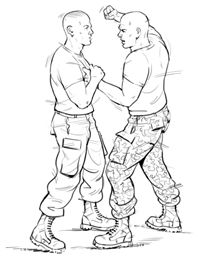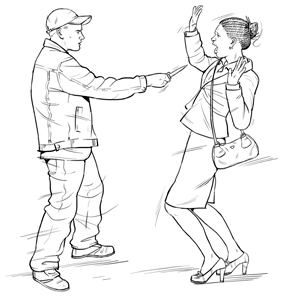
Self-defence can be defined as the act of physically resisting an assault or dealing with an assailant. There are various means that can be employed, and different people will prefer to use different methods. There is, strictly speaking, no ‘right’ or ‘wrong’ way to defend yourself. There is only what works and what does not. However, a ‘successful’ defence that lands you in jail is not as big a success as you might have hoped for.

Self-defence is not the same thing as fighting. In a fight, the goal is to defeat the opponent – to make him give up or become physically incapable of continuing. In self-defence the goal is to protect yourself, and that can be quite different.
If you have to knock an assailant out, or render him otherwise incapable of fighting, then that is what you have to do. But not for its own sake: you do it as a means to end the attack. If the attack could be ended by other means – by dissuasion or even flight – then that would be an equally valid method of getting what you want out of the situation.
Good self-defence training is always geared towards protecting you, by various means including but not limited to harming the assailant. It employs simple methods against realistic threats, and includes an understanding of the issues surrounding the use of force. It also addresses the question of what is legal and what is not, and teaches the student to work towards the goal of getting out of a situation while coming to minimal harm.
Layered Defences
Ideally, it is best not to have to ‘get physical’ with anyone. There can be no legal complications and you cannot get hurt in a fight that does not happen. Physical self-defence should be a last resort when other methods have failed. The fact that you are capable of defeating an assailant does not mean it is worth needlessly putting yourself in harm’s way or getting involved in pointless confrontations.
Your first line of defence is to recognize potential threats and stay away from them where possible. We are told from a young age not to take shortcuts down dark alleys and the like, and most of us have ignored this advice at some point. Yet it remains good advice – wherever you can, stay away from places where common sense tells you that you may be vulnerable.
The second line of defence is to be willing to walk away from a situation rather than allow it to become a confrontation. Many physical assaults result from escalation, where two individuals who do not really want to fight anger one another to the point where someone throws a punch. Keeping a cool head and being willing to just go elsewhere can greatly reduce the chances of being involved in violence.
There are, however, some situations where an individual is determined to cause you harm. Your last line of defence before matters become physical is the ability to deter aggression. Most assailants do not want a fight; they want a victim. If the potential assailant can see that you will put up a fight – win or lose – then they may decide that you are not worth the trouble.
The vast majority of situations can be dealt with or avoided altogether by the first three ‘layers’ of your defences. If violence is imminent and these measures have failed, physical self-defence is the only option remaining.
Realistic Expectations
It is necessary to approach self-defence with realistic expectations. Training is not likely to permit you to defeat 17 people at once, or to take on individuals who are much stronger and heavier than yourself with the certainty of victory. This sort of ‘perfect solution’ is used as a selling point by some instructors, but the truth is that there is no perfect solution.

Instead we must play the odds and try to obtain the best possible outcome from a given situation. An attack that ends with you hurt is a better outcome than one in which you are killed. A situation where an aggressor calls you all kinds of hurtful things and struts off to tell his friends he ‘won’ is better than a fight where you knocked him out but were yourself injured.
Training improves your odds of dealing with a given situation, but any fight is going to be a frightening and unpleasant business, and probably painful too. What good self-defence training does is prevent things going from bad to worse. If you need to defend yourself then things are already bad – there’s no point in wishing that it wasn’t happening. Instead, you must accept a fairly unpleasant reality and deal with it, never forgetting that it’s all about you and not the assailant. You win by ending the situation without coming to more harm than necessary. If that is accomplished by taking an opportunity to escape, or by demolishing an opponent, the important part of the outcome is the same.
In short, self-defence is about defending yourself, and not necessarily about harming someone else. Do what you have to, and keep an eye on the goal. That goal, one last time, is to preserve your own safety and wellbeing.
